Container Gardens | Flower Power
Patrick Shellman from Fantastic Umbrella Factory Garden shares his best tips for creating dazzling container gardens that are equal parts true grit and pizzazz. Put your sunglasses on. Gardeners spend summers soaking in sun, buoyed by breezes. It’s one of the great pleasures of our work, but those conditions can be stressful for plants, especially when […]

Arrangement 2: Full Sun
Photo Credit: Nat ReaPatrick Shellman from Fantastic Umbrella Factory Garden shares his best tips for creating dazzling container gardens that are equal parts true grit and pizzazz. Put your sunglasses on.
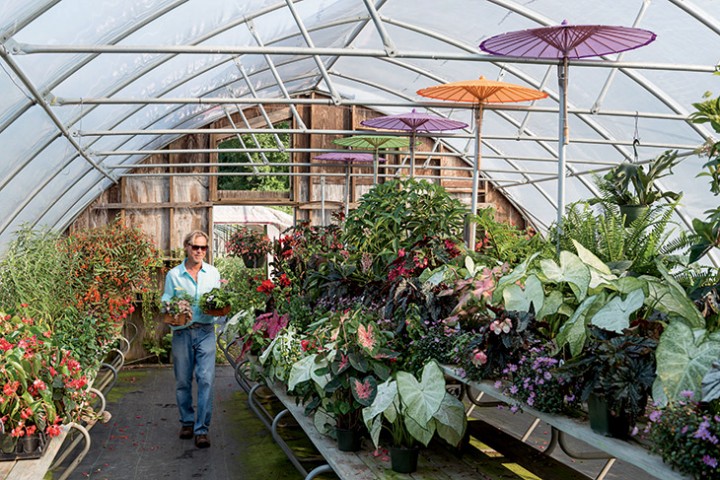
Photo Credit : Nat Rea
Gardeners spend summers soaking in sun, buoyed by breezes. It’s one of the great pleasures of our work, but those conditions can be stressful for plants, especially when they’re summering in a container. They get sunburned, they dry out with too little moisture, or they drown in too much water. Despite their billing as entry-level projects for new gardeners, containers aren’t simple, which is why so many folks flock to Patrick Shellman’s quirky Rhode Island nursery, Fantastic Umbrella Factory Gardens, every summer. He is, simply put, a master of the medium, a man whose vibrant arrangements shine with unabashed, retina-awakening zing. This man doesn’t know the definition of boring, and he knows how to build containers that last.
Shellman started on his path toward garden guruhood 34 years ago, when he came to The Fantastic Umbrella Factory in Charlestown—a rambling and colorful bazaar, with shops selling clothing, penny candy, candles, incense, and hippie crafts since 1968. “They asked if I would mow their grass,” he says. “Pretty soon, I was designing their gardens.” A year later, he put up a greenhouse and started selling anything unusual that he could lay his hands on. “But they had to be durable,” he qualifies. “I sell only ‘no fail’ plants.”
It wasn’t long before a customer asked for advice about filling a container. “Bring me the pot,” Shellman replied. Then he quizzed his client on her growing conditions: “Sun or shade? Wet or dry? Sheltered or windswept?” He designed an arrangement, discovered that he had a particular knack for it, and has been doing containers using those parameters ever since (900 walked out of his shop last summer).
These containers are hardy warriors. Not only do they take whatever the climate hands out, but these toughies laugh at conditions that would make wussier plants wither. They’re packed cheek-to-jowl with greenery—more than anyone else’s in the business—which gives them a feeling of lushness and Technicolor vibrancy.
To make his designs work under real-life conditions, Shellman follows a few rules, which you can apply at home.
Tips for Container Gardens
- Although the opening can be compact, make sure your container is deep enough for roots to plunge down.
- Work with plants that play well together and don’t upstage one another. Shellman limits his use of coleus, for example, because they tend to steal the show, grow too fast, and muscle out bedfellows (trailing coleus is the exception). Ask your nursery for plants that won’t gobble up a disproportionate amount of real estate, water, or root space.
- Know the ultimate proportions of the plants you select—something that’s not always obvious when they’re babies. You can use miniatures, but only if they won’t get lost in the arrangement; you can use oversize plants, but only if they won’t overwhelm the arrangement when they’re fully grown.
- Use self-cleaning plants. Nobody wants to spend precious time deadheading when you’re in summer-fun mode.
- Add fertilizer from the start. Shellman recommends timed-release 13-13-13. “When a plant uses up the available nutrition, it goes downhill,” he says. Be careful to keep slow-release fertilizer away from the stem.
- When plants are home alone, arrange for regular watering. “If you consistently let plants dry out, they fail,” Shellman warns. And don’t pull a container into the shade for your vacation and then return it all at once to its original sunny location. “It will sunburn, for sure,” Shellman says. If you must reintroduce a plant to a sunny spot, do it gradually, for a few hours a day.
- Select a potting soil with organic components to nurture growth, and make sure each plant is buried firmly.
- Always play good music around your plants (Shellman swears by it).
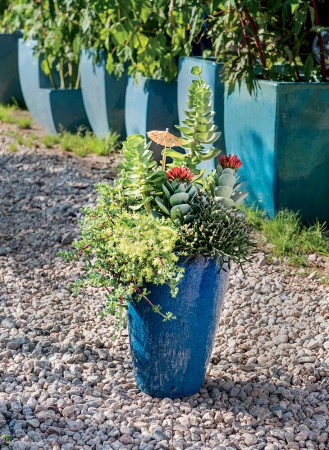
Photo Credit : Nat Rea
When the temperature soars, you need plants that will endure the sizzle. And often, drought goes hand in hand with heat. When you can’t stand ready with the hose, you need plants that won’t faint from thirst. (Try succulents—these camels of the plant kingdom love the high beams.) The following plants tolerate beating sun and don’t require constant watering. Keep them away from any overhang—these plants don’t like to be dripped on. (And if you have a shallow container, here’s where you can put it into action.)
Lampranthus blandus (pink vygie)
Portulacaria afra (rainbow bush) Sedum (stonecrop) Rhipsalis burchellii (mistletoe cactus) Crassula species (various succulents)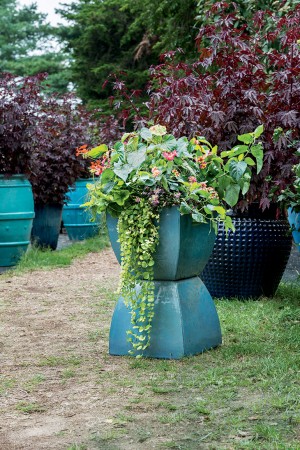
Photo Credit : Nat Rea
In a sunny location, you can bask in blossoming plants. The trick lies in selecting good bedfellows and balancing color, texture, and size to keep it from looking like a free-for-all. Carefree is also critical—you don’t want to devote your summer to deadheading blossoms. The following plants don’t wilt easily, don’t need frequent watering, and won’t burn when draped over the rim of a container. Be sure to plant them in a container with ample depth to accommodate competing roots.
Carex comans ‘Amazon Mist’ (hair sedge)
Pelargonium ‘Crystal Palace Gem’ (zonal geranium) Brachyscome ‘Surdaisy Pink’ (Swan River daisy) Begonia ‘Dragon Wing Pink’ (dragon-wing begonia) Lantana camara ‘Tropical Temptation Mimosa’ (lantana) Lysimachia nummularia ‘Aurea’ (golden creeping Jenny) Oxalis vulcanicola ‘Molten Lava’ (volcanic sorrel)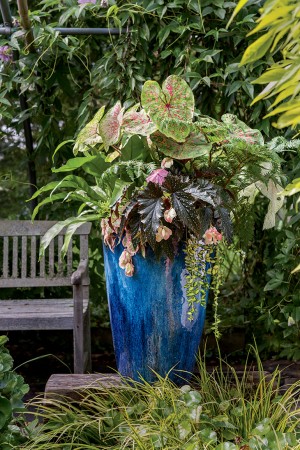
Photo Credit : Nat Rea
Brighten up the shadows with a container that pops. Although not all shady characters flower, colorful foliage, with a medley of shapes and textures, will electrify the scene. No need to continually run out with the hose when you grow in the shade—containers dry out less often when sunlight isn’t direct. (In fact, overwatering is a common issue, so watch for that.) And beware of slugs; shade is where they lurk.
Caladium ‘Raspberry Moon’ (elephant’s ear)
Begonia ‘Fannie Moser’ (angelwing begonia) Episcia ‘Cleopatra’ (flame violet) Vinca minor ‘Illumination’ (periwinkle) Alsophila australis (Australia tree fern) Selaginella kraussiana ‘Aurea’ (spike moss) Asplenium nidus (bird’s-nest fern)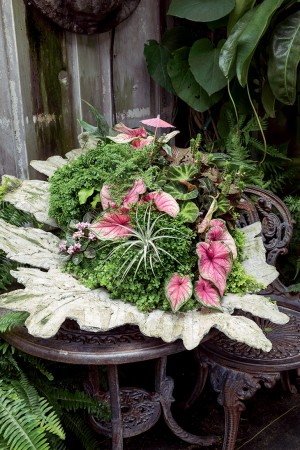
Photo Credit : Nat Rea
Whether you’re gardening by the sea, in a foggy cove, or beside a woodsy cabin, some conditions are damp. But that’s no reason to forgo a container. Many plants grow lush in a moist environment. In fact, all sorts of oddball species can be part of your scene. The following types love to get their feet wet; plant them in a shallow container with little or no drainage (most have minimal root systems), and cover the soil with lots of moss—they’ll thrive.
Selaginella kraussiana ‘Aurea’ (spike moss)
Caladium ‘Florida Sweetheart’ (elephant’s ear) Platycerium species (staghorn fern) Fittonia verschaffeltii (nerve plant) Begonia soli mutata (rhizomatous begonia) Saintpaulia cultivars (African violet) Pilea microphylla (artillery plant) Tillandsia bulbosa (air plant) Asplenium nidus (bird’s-nest fern) Sagina subulata (Irish moss)
Photo Credit : Nat Rea
It’s a given that containers will be wind-tossed beside the sea. But that’s not the only situation where gusts rake their fingers through plantings. Any container on a hill, on a terrace, or in an exposed spot will need protection; use wind blocks and ballast. And if you’re working in a particularly windy spot (for example, near the ocean), use a heavy, squat container (rather than a tall, thin one) to prevent toppling. Also, select plants with small, thin leaves that won’t get shredded in the wind. Grasses are wonderful because they not only resist shredding but dance in the breeze.
Sedum cauticola ‘Coca Cola’ (stonecrop)
Iresine herbstii ‘Blazin’ Lime’ (beefsteak plant) Lantana camara ‘Pink Caprice’ (lantana) Cyperus diffusus (umbrella plant) Manfreda undulata ‘Chocolate Chips’ (rock rose) Carex flagellifera ‘Toffee Twist’ (toffee-twist sedgeTovah Martin is the author of 14 books. In 2013, she received the Gustav Mehlquist Award—the highest honor bestowed by the Connecticut Horticultural Society. tovahmartin.com





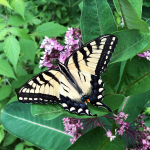


I love Your ideas of nursery’s on the East coast How about Michigan Please
Love this piece on Umbrella Factory Gardens, how about a follow up??